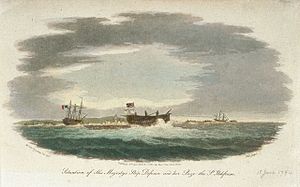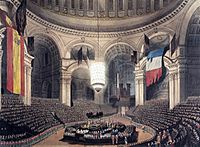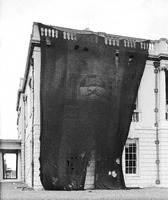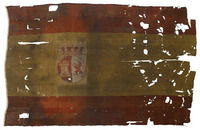Spanish ship San Ildefonso facts for kids

The San Ildefonso going into Portsmouth harbour on 12 June 1814, drawn by John Christian Schetky
|
|
Quick facts for kids History |
|
|---|---|
| Name | San Ildefonso |
| Namesake | Town of San Ildefonso, Segovia, Spain |
| Ordered | 23 February 1784 |
| Builder | Cartagena |
| Laid down | 26 March 1784 |
| Launched | 22 January 1785 |
| Captured | 21 October 1805 |
| Name | HMS Ildefonso |
| Acquired | 21 October 1805 |
| Commissioned | 3 April 1806 |
| Decommissioned | 19 June 1806 |
| Recommissioned | 22 July 1808 |
| Reclassified | As a storeship late 1808 |
| Fate | Broken up in July 1816 |
| General characteristics | |
| Class and type | Seventy-four (third rate) |
| Armament |
|
The San Ildefonso was a famous warship of the Spanish Navy. It was built in Cartagena, Spain and launched in 1785. This ship was special because it was designed to be faster and lighter than other Spanish warships. This was important because Spanish ships often struggled to keep up with the Royal Navy (British navy) in battles.
Even though it was called a "74-gun ship," the San Ildefonso actually carried 80 cannons and howitzers by the time of the Battle of Trafalgar. It fought against French and British ships in the late 1700s. The ship also sailed to the Americas twice. In 1805, during the Battle of Trafalgar, the British captured the San Ildefonso. It was then used by the Royal Navy and renamed HMS Ildefonso.
Contents
Building a Faster Warship
The San Ildefonso was a big step forward in how ships were built in Spain during the 1700s. Spanish admirals (navy leaders) were worried because their ships weren't as fast as British ones. So, they decided to try new ideas to make the San Ildefonso quicker.
Instead of heavy iron bolts, the ship used lighter wooden pegs called treenails to hold its parts together. The top parts of the ship were made from lighter pine and cedar wood instead of heavy oak. This helped lower the ship's center of gravity, making it more stable. The ship was also built a bit shorter than other Spanish 74-gun ships. All these changes helped the San Ildefonso become a much faster warship.
Ship's Weapons
When the San Ildefonso was first finished, it had 74 guns. But over time, its weapons were updated. By the time of the Battle of Trafalgar, it actually carried 80 guns!
These weapons included:
- 28 large 24-pounder guns on its lower deck.
- 30 large 24-pounder guns on its upper deck (these replaced older, smaller guns).
- Smaller 8-pounder guns and powerful 30-pounder howitzers on its quarterdeck and forecastle.
- Six 24-pounder howitzers on its poop deck (the highest deck at the back).
Unlike many other Spanish warships, the San Ildefonso did not carry small 4-pounder anti-personnel howitzers.
The San Ildefonso was designed by José Romero Fernández de Landa and built in Cartagena, Spain. Its construction started in March 1784 and it was launched in January 1785. After some tests, the ship was often kept in reserve, meaning it wasn't actively used for long periods.
In 1788, the ship was refitted and tested again. It was put back into reserve later that year. It was reactivated in April 1789 and sailed to Cadiz, getting a little damaged on the way. After another short time in reserve, its inside layout was changed.
From 1793, the San Ildefonso spent four years fighting against the French and British navies. In March 1797, it returned to Cadiz. The British navy then blockaded the port, trapping the ship there.
Between 1798 and 1802, the San Ildefonso sailed to America twice. It helped protect groups of galleons (large sailing ships) carrying goods. A famous artillery officer named Luis Daoiz de Torres served on the ship during these trips. He later became a hero for leading Spanish forces against French troops. The San Ildefonso was put into reserve one last time in 1802. After some more repairs in 1805, it joined the main Spanish fleet just before the Battle of Trafalgar. Even though it had been in service for 21 years, it spent 9 of those years in reserve and had not fought in any major battles until Trafalgar.
Capture and British Service
During the Battle of Trafalgar, the San Ildefonso was commanded by Brigadier José de Vargas. It was captured by the British warship HMS Defence. The Defence was at the back of the British line, so it joined the battle later. Before fighting the San Ildefonso, it had already damaged a French ship.
The San Ildefonso was already damaged when the Defence attacked it. After a tough fight that lasted less than an hour, the Spanish ship surrendered. It had lost 34 sailors and 126 were wounded. The Defence successfully towed the San Ildefonso to Gibraltar, and both ships survived the big storm that hit after the battle.
The British navy took the ship into their service and renamed it HMS Ildefonso. It stayed in Portsmouth until April 1806. Then, Captain John Quilliam, a hero from Trafalgar, took command. The ship was taken out of service in June but brought back in July 1808 under Captain Edward Harvey. Later that year, it was decommissioned again and used as a storeship in Portsmouth and Spithead. After the Napoleonic Wars ended, the ship was no longer needed. It was taken apart in July 1816.
San Ildefonso's Flag
The huge naval ensign (flag) that the San Ildefonso flew at the Battle of Trafalgar was 145 square meters (about 1,560 square feet) in size. This flag, which was damaged during the battle, was displayed at Admiral Nelson's funeral in St Paul's Cathedral on January 9, 1806. In 1907, the cathedral gave the flag to the National Maritime Museum in Greenwich.
-
In 1962 the ensign was draped over the parapet of the Queen's House for photography
-
Presently at the National Maritime Museum, Greenwich





